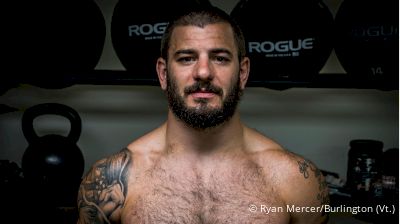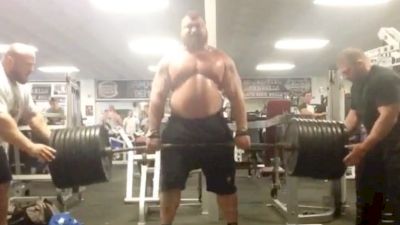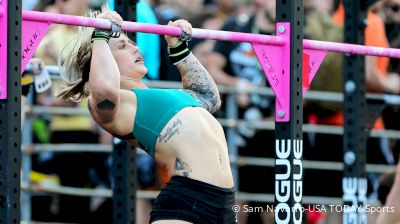How Will Regionals Be Different In 2018?
How Will Regionals Be Different In 2018?
We know the 2018 CrossFit Games Regionals will be different, but how could the Games qualification process change to fix some of the issues in the current system?

The CrossFit Games found a new home in 2017, moving to Madison, Wisconsin, after seven years in Carson, California, and with the new venue came a whole set of changes around the schedule, competition, and more. But what about the rest of the CrossFit Games season? We know that the 2018 Regionals will be different, but what can we expect to change?
The key aim of the CrossFit Games from a competitive standpoint is to find the Fittest On Earth. The entire system is designed to that end, starting with the Open, then to Regionals, and then to the Games. The biggest issue CrossFit has right now is the massive size and talent difference in the regions, both during the Open and in the groups of regions during Regionals.
For example, here are some rough estimates on how many female competitors there are in each region during the Open:
A couple things should stick out here, and first and foremost is the huge disparity in size between the largest and smallest regions. There are over 21,000 women competing in Europe during the Open, which is more than some of the combined Regionals. Because of the size difference, there's a difference in depth of talent in those regions, and yet that depth of talent isn't necessarily recognized in the setup we currently have at Regionals.
There are obviously geographical considerations taking place with the formations of the Regional competitions, so what can CrossFit change to make sure that A) the most talented CrossFitters are making it to Regionals and B) the best CrossFitters are making it to the Games?
While the Meridian Regional has nearly 25,000 female competitors in it during the Open, the California Regional has less than half of that, but each competition gets five spots to the Games. If we're looking at it proportionally, Meridian should get double the representation at the Games.
One solution to the issues at hand would be to leave the Regionals alone but change the number of qualifying spots per Regional to an amount proportional to the number of athletes.
Another solution is to redraw the regions to even out the populations represented both outside and inside the U.S. Instead of 17 regions during the Open feeding into eight Regional competitions, the number of Open regions can be increased but feed into a smaller number of Regionals. That would allow for less people from each region to qualify for the Regional competitions through the Open.
Conversely, the regions during the Open can expand to cover the same ground as the Regionals so only the best qualify to advance.
Combining these two solutions could be a good way to solve multiple problems at once. In this example, the areas covered by each Regional becomes the competition ground for the Open. So for the Meridian, the top 40 athletes from Europe and Africa qualify for Regionals without the current weighted qualification of 30 from Europe and 10 from Africa. Then, at Regionals, the number of Games spots awarded is increased proportionally to the size of the region during the Open.
Both of these solutions assume that while Regionals will change, they won't change dramatically. What happens if CrossFit decides it wants to reorganize the whole system? What could it construct to achieve its goals of A) casting the widest net possible and B) finding the Fittest on Earth if it wasn't married to the current format?
We have a global leaderboard during the Open, but it currently doesn't mean anything. One solution to ensure the best of the best are making it to Regionals (and therefore to the Games) is to use the global leaderboard as the qualifying grounds for the second stage of the Games season. In this scenario, the top 300 men and 300 women worldwide are invited to compete for a chance to qualify for the Games regardless of where they place in their state, country, or region.
Regionals can then take place over two weekends, with three competitions happening each weekend. The Regionals themselves can be organized geographically for ease of access, and all competitors are combined on the same leaderboard over each weekend so that, again, the top combined competitors make it to the Games.
The Global Leaderboard solution would make it even tougher to qualify for the CrossFit Games, with a much smaller margin of error in any of the qualifying stages while also rewarding the competitors who consistently place at the top of the world among the best of the best.
There are myriad ways Regionals and the Games qualifying process can be reorganized, and only those within the highest levels of CrossFit HQ really know how and where things are going. What do you think of these solutions? Am I missing the core issues at hand? Is there a simpler way to do this?
Don't miss breaking news, feature stories, event updates, and more. Sign up for the FloElite mailing list today.
The key aim of the CrossFit Games from a competitive standpoint is to find the Fittest On Earth. The entire system is designed to that end, starting with the Open, then to Regionals, and then to the Games. The biggest issue CrossFit has right now is the massive size and talent difference in the regions, both during the Open and in the groups of regions during Regionals.
For example, here are some rough estimates on how many female competitors there are in each region during the Open:
| Region | Amount Of Competitors |
|---|---|
| Africa | 3,900 |
| Asia | 3,300 |
| Australia | 10,650 |
| Canada East | 6,350 |
| Canada West | 3,600 |
| Central East | 9,900 |
| Europe | 21,750 |
| South America | 12,650 |
| Mid Atlantic | 11,350 |
| North Central | 12,100 |
| North East | 14,400 |
| NorCal | 5,250 |
| Northwest | 6,550 |
| South Central | 12,450 |
| South East | 11,300 |
| SoCal | 6,250 |
| South West | 8,100 |
A couple things should stick out here, and first and foremost is the huge disparity in size between the largest and smallest regions. There are over 21,000 women competing in Europe during the Open, which is more than some of the combined Regionals. Because of the size difference, there's a difference in depth of talent in those regions, and yet that depth of talent isn't necessarily recognized in the setup we currently have at Regionals.
There are obviously geographical considerations taking place with the formations of the Regional competitions, so what can CrossFit change to make sure that A) the most talented CrossFitters are making it to Regionals and B) the best CrossFitters are making it to the Games?
Proportional qualifications
While the Meridian Regional has nearly 25,000 female competitors in it during the Open, the California Regional has less than half of that, but each competition gets five spots to the Games. If we're looking at it proportionally, Meridian should get double the representation at the Games.
One solution to the issues at hand would be to leave the Regionals alone but change the number of qualifying spots per Regional to an amount proportional to the number of athletes.
Redrawing and expand the regions
Another solution is to redraw the regions to even out the populations represented both outside and inside the U.S. Instead of 17 regions during the Open feeding into eight Regional competitions, the number of Open regions can be increased but feed into a smaller number of Regionals. That would allow for less people from each region to qualify for the Regional competitions through the Open.
Conversely, the regions during the Open can expand to cover the same ground as the Regionals so only the best qualify to advance.
Combination of expanded regions and proportional qualifiers
Combining these two solutions could be a good way to solve multiple problems at once. In this example, the areas covered by each Regional becomes the competition ground for the Open. So for the Meridian, the top 40 athletes from Europe and Africa qualify for Regionals without the current weighted qualification of 30 from Europe and 10 from Africa. Then, at Regionals, the number of Games spots awarded is increased proportionally to the size of the region during the Open.
Both of these solutions assume that while Regionals will change, they won't change dramatically. What happens if CrossFit decides it wants to reorganize the whole system? What could it construct to achieve its goals of A) casting the widest net possible and B) finding the Fittest on Earth if it wasn't married to the current format?
The Global Leaderboard Qualification
We have a global leaderboard during the Open, but it currently doesn't mean anything. One solution to ensure the best of the best are making it to Regionals (and therefore to the Games) is to use the global leaderboard as the qualifying grounds for the second stage of the Games season. In this scenario, the top 300 men and 300 women worldwide are invited to compete for a chance to qualify for the Games regardless of where they place in their state, country, or region.
Regionals can then take place over two weekends, with three competitions happening each weekend. The Regionals themselves can be organized geographically for ease of access, and all competitors are combined on the same leaderboard over each weekend so that, again, the top combined competitors make it to the Games.
The Global Leaderboard solution would make it even tougher to qualify for the CrossFit Games, with a much smaller margin of error in any of the qualifying stages while also rewarding the competitors who consistently place at the top of the world among the best of the best.
There are myriad ways Regionals and the Games qualifying process can be reorganized, and only those within the highest levels of CrossFit HQ really know how and where things are going. What do you think of these solutions? Am I missing the core issues at hand? Is there a simpler way to do this?
FloElite's best content, delivered to your inbox
Don't miss breaking news, feature stories, event updates, and more. Sign up for the FloElite mailing list today.
Related Content
 Olympic Runner Leo Manzano: My First Victory
Olympic Runner Leo Manzano: My First VictorySep 17, 2021
 Five-Time CrossFit Champ Mat Fraser Retires
Five-Time CrossFit Champ Mat Fraser RetiresFeb 3, 2021
 Get The FloSports App
Get The FloSports AppNov 17, 2020
 FloSports Partners With Rx Sports
FloSports Partners With Rx SportsSep 16, 2020
 Eddie Hall Is Still A Beast
Eddie Hall Is Still A BeastSep 1, 2020
 Eric Roza Named CEO & Owner Of CrossFit
Eric Roza Named CEO & Owner Of CrossFitJun 24, 2020
 We Stand With You
We Stand With YouJun 2, 2020
 Everything You Need To Prepare For Murph
Everything You Need To Prepare For MurphMay 21, 2020
 Happy Birthday Chad Vaughn
Happy Birthday Chad VaughnMay 11, 2020